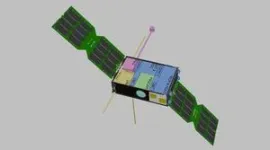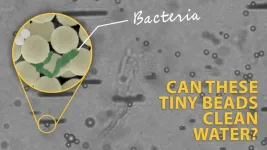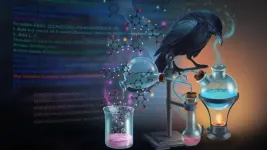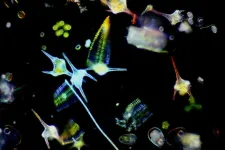(Press-News.org) The author of a disaster novel couldn't have dreamed it up any better: On a Friday, the thirteenth of all days, the potentially dangerous asteroid (99942) Apophis will come extremely close to humanity. On 13 April 2029, there will only be around 30,000 kilometres between the cosmic rock and Earth. It will then be possible to see Apophis with the naked eye as a point of light in the evening sky, even from Würzburg.
What makes the asteroid so dangerous: its average diameter is an impressive 340 metres. If it were to hit the Earth, the destruction caused by an impact on land would be enormous. "The impact crater alone would probably have a diameter of several kilometres, and the force of the impact could devastate an area the size of Central Europe," estimates Jonathan Männel, research associate at the Professorship for Space Technology at Julius-Maximilians-Universität Würzburg (JMU) in Bavaria, Germany.
But don't panic: At least for the next 100 years, Apophis will spare the Earth, as NASA has calculated. Since the asteroid was discovered in 2004 and classified as dangerous, the US and other space organisations have been keeping a close eye on its orbit and now know that it will fly past the Earth.
Apophis Offers a Rare Opportunity for Research
Asteroids are irregularly shaped objects that move in orbits around the sun. To date, around 1.3 million asteroids are known to exist in our solar system, and around 2500 are considered potentially hazardous for the Earth. Potentially Hazardous Asteroids (PHA) are near-Earth asteroids whose orbits are less than 20 lunar distances from the Earth’s orbit and whose diameter is of over 140 meters (460 ft). Science does not know very much about asteroids: to date, there have only been around 20 satellite missions that have targeted these celestial bodies.
What is the structure of asteroids? What influences their trajectory? What happens to them when they fly close to other objects and feel their gravitational pull? There are many questions to be answered. Because an asteroid of this size only comes so close to Earth every 1000 years, there is a rare opportunity to study the asteroid with relatively little effort. In doing so, mankind could also gain knowledge that could be used to develop defence measures against dangerous asteroids.
Three Concepts are Scrutinised
What contribution could Germany make to the research into Apophis? A JMU team led by aerospace engineer Professor Hakan Kayal is investigating this question in the NEAlight project.
With around 300,000 euros in funding from the Federal Ministry for Economic Affairs and Climate Action, currently the project leader Jonathan Männel and research assistants Tobias Neumann and Clemens Riegler are investigating three concepts for German small satellite missions. All three are based on the results of the SATEX project from 2023, in which the Würzburg team analysed the potential of small satellites for interplanetary missions.
Concept number one: For a national mission, Kayal's team is building a small satellite that will accompany the asteroid Apophis for two months on its way to its closest point to Earth and stay with it for a few weeks afterwards. During this time, the changes in Apophis will be documented photographically and analysed using various measurements. This strategy poses a number of technical challenges, as the small satellite has to cover a long distance and function largely autonomously.
Concept number two: Germany is participating in the planned European RAMSES mission. This envisages a larger satellite, equipped with small satellites, telescopes and other measuring instruments, which will fly to Apophis and accompany it on its flyby of the Earth over a longer period of time. One of the small satellites could be from Würzburg and study the asteroid in conjunction with the other satellites. For the JMU team, the technical effort involved would be less and the scientific knowledge gained would be greater. Whether the RAMSES mission is ultimately realised also depends on the willingness of the European ESA partners to co-finance the project.
Concept number three: A small satellite built at JMU flies briefly past the asteroid when it is closest to Earth and takes photos. This would demonstrate that such a mission is also possible with inexpensive small satellites. The effort involved would be relatively small, but the observation time would be short and the knowledge gained would probably be rather small. This mission could begin a few days before the arrival of Apophis – with the first two concepts, the satellite would have to be launched a year earlier.
Elaboration of the Scenarios by April 2025
In the NEAlight project, Kayal's team will work out the requirements for these three mission scenarios in detail, define the basic mission architectures and evaluate the realisation options. It will also use the three concepts to consider realisation options for future interplanetary small satellites that fly to the moon or other near-Earth asteroids (NEA), for example.
The project was launched at the beginning of May 2024 and will run for one year. It is being carried out at the Interdisciplinary Research Centre for Extraterrestrial Studies (IFEX) at the JMU Professorship for Space Technology.
The project "Investigation of small satellite mission ideas to Near Earth Astroids (NEA) with a focus on (99942) Apophis" (NEAlight) is funded by the German Aerospace Centre (DLR) with around 306,000 euros from funds of the Federal Ministry of Economics and Climate Action on the basis of a decision of the German Bundestag under the funding code 50OO2413.
END
Exploring the asteroid apophis with small satellites
2024-05-08
ELSE PRESS RELEASES FROM THIS DATE:
Research warns of hazardous health risks from flavored vapes
2024-05-08
Research warns of hazardous health risks from flavoured vapes
Research predicts the potential formation of 127 acutely toxic chemicals in flavoured vapes
Findings underscore the urgent need for comprehensive regulation of vaping products
Wednesday, 8 May 2024: New research has uncovered the potentially harmful substances that are produced when e-liquids in vaping devices are heated for inhalation. The study, published in Scientific Reports, highlights the urgent need for public health policies concerning flavoured vapes.
The research team at RCSI University of Medicine and Health Sciences, Dublin, used artificial ...
FAU researchers receive $1M in FDOH grants to fight Alzheimer’s disease
2024-05-08
Three Florida Atlantic University researchers at the forefront of Alzheimer’s disease (AD) research have each received a $350,000 grant from the Florida Department of Health’s “Ed and Ethel Moore Alzheimer’s Disease Research Program.”
The Ed and Ethel Moore Alzheimer’s Disease Research Program was established to improve the health of Floridians by stimulating research into the prevention, diagnosis, treatment, care management and cure of AD.
Florida has the second highest incidence of AD in the nation with 580,000 people ages 65 and ...
Swarms of miniature robots clean up microplastics and microbes, simultaneously (video)
2024-05-08
When old food packaging, discarded children’s toys and other mismanaged plastic waste break down into microplastics, they become even harder to clean up from oceans and waterways. These tiny bits of plastic also attract bacteria, including those that cause disease. In a study in ACS Nano, researchers describe swarms of microscale robots (microrobots) that captured bits of plastic and bacteria from water. Afterward, the bots were decontaminated and reused. Watch a video of them swarming.
The size ...
Where wildlife is welcome
2024-05-08
How do city residents feel about animals in their immediate surroundings? A recent study by the Technical University of Munich (TUM), the University of Jena and the Vienna University of Technology shows how different the acceptance of various wild animals in urban areas is. Important factors are the places where the animals are found and their level of popularity - squirrels and ladybugs come out on top here. The results have important implications for urban planning and nature conservation.
The relationship between city inhabitants and urban animals is complex, ...
THC lingers in breastmilk with no clear peak point
2024-05-08
PULLMAN, Wash. – When breastfeeding mothers in a recent study used cannabis, its psychoactive component THC showed up in the milk they produced. The Washington State University-led research also found that, unlike alcohol, when THC was detected in milk there was no consistent time when its concentration peaked and started to decline.
Importantly, the researchers discovered that the amount of THC they detected in milk was low – they estimated that infants received an average of 0.07 mg of THC per day. For comparison, a common low-dose edible contains 2 mg of THC. The research team stressed that it is unknown whether this amount has any impact ...
An AI leap into chemical synthesis
2024-05-08
Chemistry, with its intricate processes and vast potential for innovation, has always been a challenge for automation. Traditional computational tools, despite their advanced capabilities, often remain underutilized due to their complexity and the specialized knowledge required to operate them.
Now, researchers with the group of Philippe Schwaller at EPFL, have developed ChemCrow, an AI that integrates 18 expertly designed tools, enabling it to navigate and perform tasks within chemical research with unprecedented efficiency. “You might wonder why a crow?” asks Schwaller. “Because ...
U of T researchers lead discovery of natural compounds that selectively kill parasites
2024-05-08
An international team led by researchers at the University of Toronto has found a family of natural compounds with potential as new and more effective treatments for parasitic worms. The compounds stall the unique metabolic process that worms use to survive in the human gut.
Parasitic worms transmitted through soil wreak havoc in developing countries in the tropics. Infection by these parasites leads to malaise, weakness, malnutrition and other debilitating symptoms, and can cause developmental defects in children and impair their growth.
“Soil-transmitted parasitic worms infect over one billion people around the world, typically in low-income communities of developing countries ...
Limited adaptability makes freshwater bacteria vulnerable to climate change
2024-05-08
Freshwater resources are limited, accounting for only 3.5% of Earth’s water, with just 0.25% accessible on the surface. Nevertheless, freshwater lakes are essential for ecosystem functioning and global carbon cycling due to their high biological productivity and microbial activity. They are critical to human survival, providing drinking water, supporting agriculture, fisheries, and recreation. However, climate change – particularly rising temperatures – threatens these habitats by disrupting microbial communities that are essential for nutrient cycling and water quality maintenance.
Challenging established evolutionary paradigms
“Considering ...
Gene linked to learning difficulties has direct impact on learning and memory
2024-05-08
A gene previously linked to intellectual disability has been found to regulate learning and memory in mice.
The gene, called KDM5B has previously been linked to some intellectual disability disorders and autism. In the general population, some variants are also associated with reduced brain function, although not sufficient to cause an overt disability or behavioural symptoms.
Now, researchers at King’s College London, the University of Exeter and the University of California Irvine have found that reduced function of the gene in the brain results in loss of learning ability and memory and a reduction in the brain’s ability to strengthen connections between neurons, ...
Study: Pressure to be “perfect” causing burnout for parents, mental health concerns for their children
2024-05-08
COLUMBUS, OHIO – Is the status of “perfect parent” attainable?
Researchers leading a national dialogue about parental burnout from The Ohio State University College of Nursing and the university’s Office of the Chief Wellness Officer say “no,” and a new study finds that pressure to try to be “perfect” leads to unhealthy impacts on both parents and their children.
The survey of more than 700 parents nationwide from June 15 – July 28, 2023 is summarized in the new report, “The Power of Positive Parenting: Evidence to Help Parents and Their Children Thrive.” The data shows that:
Fifty-seven ...







